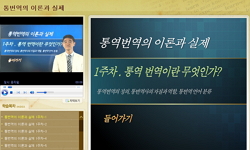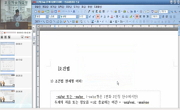이 논문은 지금까지 연구된 고려속요의 현대어 번역을 살펴 앞으로의 연구 방향을 제시함과 함께 문학 교과서 및 외국어 번역 대상으로서의 현대역 정전을 수립하는데 그 목적이 있다. 고려...
http://chineseinput.net/에서 pinyin(병음)방식으로 중국어를 변환할 수 있습니다.
변환된 중국어를 복사하여 사용하시면 됩니다.
- 中文 을 입력하시려면 zhongwen을 입력하시고 space를누르시면됩니다.
- 北京 을 입력하시려면 beijing을 입력하시고 space를 누르시면 됩니다.
https://www.riss.kr/link?id=A99616163
- 저자
- 발행기관
- 학술지명
- 권호사항
-
발행연도
2012
-
작성언어
Korean
-
주제어
고려속요 ; 현대어역 ; 현대역 ; 번역 ; 직역 ; 의역 ; 문학 교과서 ; 시어 ; 여음구 ; 서술어 ; 화자 발화 ; Goryeo folk song ; modern translation ; translation ; literal translation ; liberal translation ; literary textbook ; poetic word ; Yeoeum phrase ; predicate ; utterance of speaker
-
KDC
810.5
-
등재정보
KCI등재
-
자료형태
학술저널
- 발행기관 URL
-
수록면
167-196(30쪽)
-
KCI 피인용횟수
1
- DOI식별코드
- 제공처
-
0
상세조회 -
0
다운로드
부가정보
국문 초록 (Abstract)
이 논문은 지금까지 연구된 고려속요의 현대어 번역을 살펴 앞으로의 연구 방향을 제시함과 함께 문학 교과서 및 외국어 번역 대상으로서의 현대역 정전을 수립하는데 그 목적이 있다. 고려속요의 현대역 상황을 보면, 번역 건수는 130여건으로 편당 평균 6.7건이 이루어 졌으며, 직역과 의역의 비율은 7:3으로 직역이 앞섰다. 번역물들을 직역과 의역에 따라 시어, 여음, 서술어, 화자의 발화 방식 등으로 나누어 살폈다. 그 결과 시어에서 직역을 수행한 이들은 시어의 생략과 오역이 적지 않았으며, 의역한 연구자들은 원전을 벗어난 번역, 원전의 구성을 바꾸는 번역을 하기도 하였다. 여음의 번역에서 직역자들은 여음을 원전 그대로 옮기거나 생략하였으며, 의역자 가운데는 시적 기능을 살려 의미역을 하기도 하였다. 서술어 번역에서 직역자는 원전의 고어투를 그대로 옮기는 경우가 많았으며, 의역자는 작품을 다시 구성하여 설명하는 방식으로 옮겼다. 또한 역자마다 서술어 번역을 시제와 정서를 달리하기도 하였다. 화자의 발화 번역에서 등장인물이 여럿일 지라도 직역자는 단수 화자의 목소리로, 의역자는 복수 화자의 톤으로 옮겼다. 이런 결과 시어와 여음구에 대한 옳은 번역이 없었고, 서술어 번역에서 어학적 고려를 충분히 하지 않았으며, 화자의 발화 처리 방식이 작품 해석의 다양성을 오히려 제한 하기도 하였다. 이런 문제를 극복하기 위해 필자는 다음을 제시하였다. 시어의 번역은 난해어구는 명확한 해독이 나오기를 기다리고 분명하고 오류가 적은 어석을 적극 반영하며, 여음구의 번역은 넘치는 의역을 피하여 원전대로 옮기며, 서술어의 번역은 문법 규칙을 따르면서 운문 갈래의 미감을 살리며, 화자의 발화 번역은 단·복수를 고려하여 해석의 제한을 두지 않기 등이 그것이다. 그리고 중등 문학 교과서들에서 현재의 현대역을 활용함으로써 나타난 문제점과 번역 대상으로 삼을만한 현대역이 없어 발생한 서구어 번역물에 보이는 혼란과 오역들이 극복하기 위해, 현대역의 정전 정립을 위한 공동 작업과 용도와 수용자를 고려한 현대역의 다품종 생산을 제언하였다. 이상의 노력이 어려운 일임은 분명하지만 현대어역의 학문적 가치, 교육적 의미 그리고 한국문학의 세계화에 작지 않은 보탬이 되리라 믿는다.
다국어 초록 (Multilingual Abstract)
The purpose of this article is to suggest the future research by searching modern translation of Goryeo folk song studied up to now and to establish canon of modern translation as a subject of translation of literary textbook and foreign languages. In...
The purpose of this article is to suggest the future research by searching modern translation of Goryeo folk song studied up to now and to establish canon of modern translation as a subject of translation of literary textbook and foreign languages. In situation of modern translation of Goryeo folk song, the number of translated folk songs are around 130 and its average is 6.7. In this case, the ratio between literal translation and liberal translation was 7:3 and the cases of literal translations were more. We have researched translations by dividing into poetic words, Yeoeum, predicate, and utterance of speaker according to literal & liberal translation. As a result, the translators who made literal translation in poetic words had many omissions and mistranslation parts while those who made liberal translation in poetic words missed the points of original songs or changed the constructions of original songs. In translation of Yeoeum, literal translators translated them as they were in original songs or omitted them while some of liberal translators translated liberally by emphasizing its poetic function. In predicate translation, most of literal translators translated by expressing tones of archaic words as they were but liberal translators translated in a method to reconstruct and explain the works. In addition, each translator differs tense and emotion in predicate translation. In case of multiple characters in speaker``s utterance translation, literal translators translated as the utterance of single speaker but liberal translators as the utterance of multiple speakers. As a result of the above, there was no correct translation to poetic words and Yeoeum phrases, linguistic consideration was not enough in predicate translation, and a method of speaker``s utterance rather restricted a diversity of interpretation in works. In order to overcome such problem, I, the author of this article suggest followings: In translation of poetic words, we have to wait for clear interpretation for difficult phrases, have to reflect clear & less errors of interpretation actively, have to translate as the original songs by avoiding liberal translation in Yeoeum phrases, have to emphasize an esthetic sense of poetry section by observing grammar rules in predicate translation, and have not to restrict the interpretation in translation of speaker``s utterance by considering singular and plural. In addition, in order to overcome the problems indicated in middle & high school literary textbooks by using current modern translation and confusions & mistranslations in western translations which have been occurred because of no modern translation to be a subject in translation, I suggested various kinds of modern translation considering co-work, use, and readers for canon of modern translation. It is obvious that above efforts are very difficult but I believe that they would be a help to scholarly value & educational meaning of modern translation and the globalization of Korean literature.
참고문헌 (Reference)
1 김완진, "향가와 고려가요" 서울대학교 출판부 2000
2 지헌영, "향가여요신석" 정음사 1947
3 김흥규, "한국고전문학과 비평의 성찰" 고려대학교 출판부 2002
4 차재은, "청산별곡 해석 문제"
5 정병욱, "증보판 한국고전시가론" 신구문화사 1991
6 장효현, "이상곡의 생성에 대한 고찰" 92 : 1984
7 임기중, "우리의 옛노래" 현암사 1993
8 윤성현, "우리 옛노래 모둠" 보고사 2011
9 양주동, "여요전주" 을유문화사 1947
10 이등룡, "여요석주" 한국학술정보 2010
1 김완진, "향가와 고려가요" 서울대학교 출판부 2000
2 지헌영, "향가여요신석" 정음사 1947
3 김흥규, "한국고전문학과 비평의 성찰" 고려대학교 출판부 2002
4 차재은, "청산별곡 해석 문제"
5 정병욱, "증보판 한국고전시가론" 신구문화사 1991
6 장효현, "이상곡의 생성에 대한 고찰" 92 : 1984
7 임기중, "우리의 옛노래" 현암사 1993
8 윤성현, "우리 옛노래 모둠" 보고사 2011
9 양주동, "여요전주" 을유문화사 1947
10 이등룡, "여요석주" 한국학술정보 2010
11 김명준, "악장가사 주해" 다운샘 2004
12 김명준, "악장가사" 지식을만드는지식 2011
13 김명준, "시용향악보" 지식을만드는지식 2011
14 박재민, "석주 고려가요" 이회 2003
15 박병채, "새로고친 고려가요 어석연구" 국학자료원 1994
16 "봉좌문고본(蓬左文庫本) 악학궤범(樂學軌範)"
17 "봉좌문고본(蓬左文庫本) 악장가사(樂章歌詞)"
18 고형진, "문학 II" 천재문화 2011
19 우병환, "문학 II" 비상교평 2011
20 이숭원, "문학 II" 신사고 2011
21 강명혜, "고려속요·사설시조의 새로운 이해" 북스힐 2002
22 김명준, "고려속요(高麗俗謠)의 외국어 번역 현황과 과제" 우리문학회 (34) : 3-37, 2011
23 최철, "고려국어가요의 해석" 연세대학교출판부 1996
24 김진희, "고려가요 여음구와 반복구의 문학적․음악적 의미" 한국시가학회 31 : 101-130, 2011
25 전규태, "고려가요" 정음사 1968
26 김태준, "고려가사의 일종-만전춘별사에 대하여고"
27 김태준, "고려가사" 학예사 1939
28 여증동, "고려 처용 노래 연구, In 고려가요연구" 백문사 1979
29 김태준, "고가청산별곡" 2 : 1934
30 홍기문, "고가요집" 국립문화예술서적출판사 1959
31 김형규, "고가요주석" 일조각 1969
32 강헌규, "고가요의 주석적 연구 II" 한국문화사 2010
33 강헌규, "고가요의 주석적 연구" 한국문화사 2004
34 김명준, "개정판 고려속요 집성" 다운샘 2008
35 여증동, "<쌍화점> 노래 연구, In 고려시대의 가요문학" 새문사 1982
동일학술지(권/호) 다른 논문
-
릿쿄대학 시절, 윤동주의 유작시 다섯 편 -윤동주 연구3
- 한민족문화학회
- 김응교 ( Eung Gyo Kim )
- 2012
- KCI등재
-
- 한민족문화학회
- 김한샘 ( Han Saem Kim )
- 2012
- KCI등재
-
- 한민족문화학회
- 정달영 ( Dal Young Cheong )
- 2012
- KCI등재
-
- 한민족문화학회
- 정종수 ( Jong Su Jeong )
- 2012
- KCI등재
분석정보
인용정보 인용지수 설명보기
학술지 이력
| 연월일 | 이력구분 | 이력상세 | 등재구분 |
|---|---|---|---|
| 2027 | 평가예정 | 재인증평가 신청대상 (재인증) | |
| 2021-01-01 | 평가 | 등재학술지 유지 (재인증) |  |
| 2018-01-01 | 평가 | 등재학술지 유지 (등재유지) |  |
| 2015-01-01 | 평가 | 등재학술지 유지 (등재유지) |  |
| 2011-01-01 | 평가 | 등재학술지 유지 (등재유지) |  |
| 2010-02-11 | 학회명변경 | 영문명 : The Learned Society of the Korean Culture -> The Association for Korean Cultural Studies |  |
| 2010-02-11 | 학술지명변경 | 외국어명 : THE Korean Culture Journal -> The Review of Korean Cultural Studies |  |
| 2008-01-01 | 평가 | 등재학술지 선정 (등재후보2차) |  |
| 2007-07-02 | 학술지명변경 | 외국어명 : A study of Han Min Jok's culture -> THE Korean Culture Journal |  |
| 2007-01-01 | 평가 | 등재후보 1차 PASS (등재후보1차) |  |
| 2005-06-16 | 학회명변경 | 영문명 : The Learned Society Of Han-Min-Jok'S Culture -> The Learned Society of the Korean Culture |  |
| 2005-01-01 | 평가 | 등재후보학술지 선정 (신규평가) |  |
학술지 인용정보
| 기준연도 | WOS-KCI 통합IF(2년) | KCIF(2년) | KCIF(3년) |
|---|---|---|---|
| 2016 | 0.6 | 0.6 | 0.57 |
| KCIF(4년) | KCIF(5년) | 중심성지수(3년) | 즉시성지수 |
| 0.59 | 0.59 | 1.042 | 0.14 |




 KCI
KCI KISS
KISS






